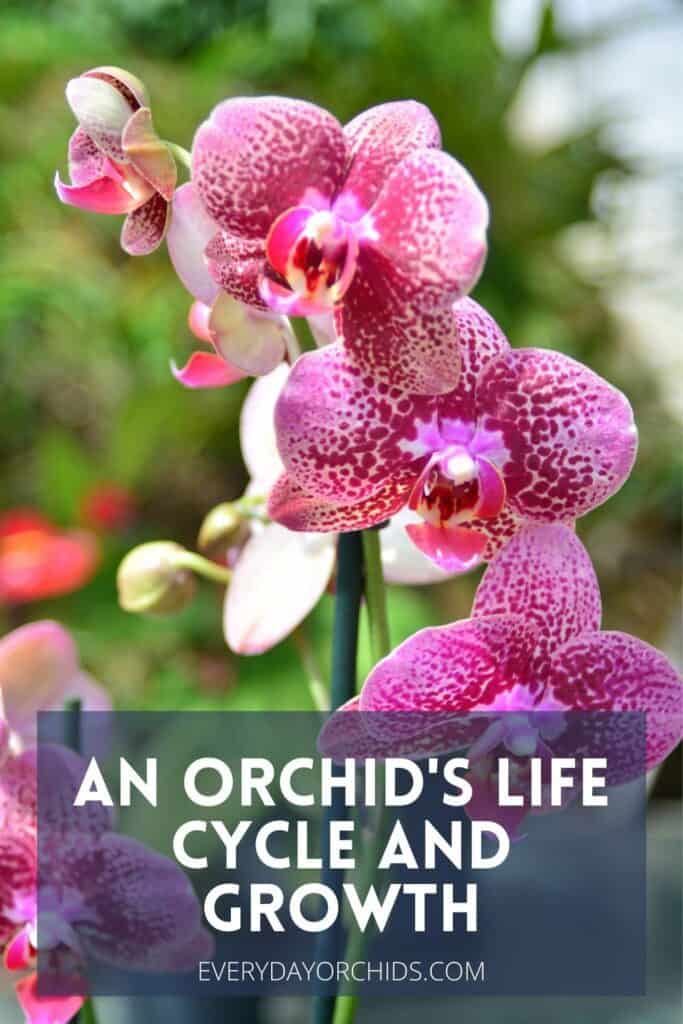If you are wondering how fast orchids grow, you’ve come to the right place. Orchids are slow-growing plants and if you are new to orchid growing, you might be surprised at how slow this growth actually is.
In fact, looking at your orchid, you might think that nothing is happening. Every couple months or so, you might see a new leaf or root bud, but is this normal? What should you expect for your orchid, and what is a typical growth rate for this plant?
Orchids grow very slowly, developing only 1 to 3 new leaves a year. Roots typically grow fastest during the warmer months of spring and summer. In a year, an orchid may develop multiple new root buds. Alternatively, new roots may branch off from existing roots. Phalaenopsis orchids usually bloom once a year and will produce at least one flower spike each blooming season.
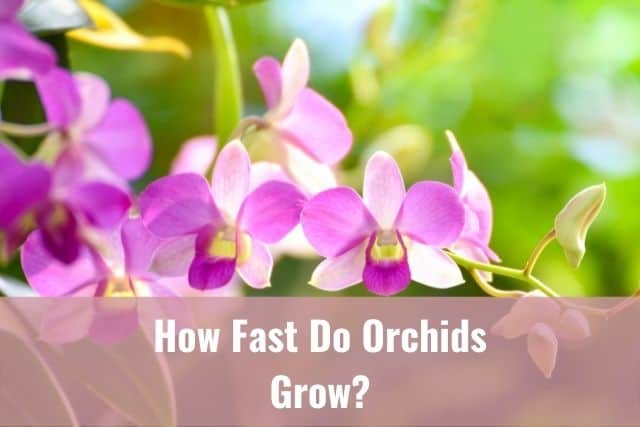
In this article, I’ll go over what you can expect in terms of how fast orchids grow. In particular, I’ll talk about orchid growth, season by season. I’ll also go over how fast Phalaenopsis orchid leaves, roots and flowers grow. You’ll learn what is normal and what isn’t.
While some of this information is more specific to Phalaenopsis orchids, all orchid species move through these seasons of growth and rest as well.
The length of time an orchid spends in each phase may vary. However, the general order in which things happen is fairly similar. Keep reading to learn more.
Please note that these links are affiliate links and as an Amazon Associate, I earn from qualifying purchases. Purchases made through affiliate links in this post may generate commissions at no additional cost to you. Use this link for a discounted Amazon Prime trial. Thank you for your support!
Table of Contents
Seasons Of Orchid Growth and Rest
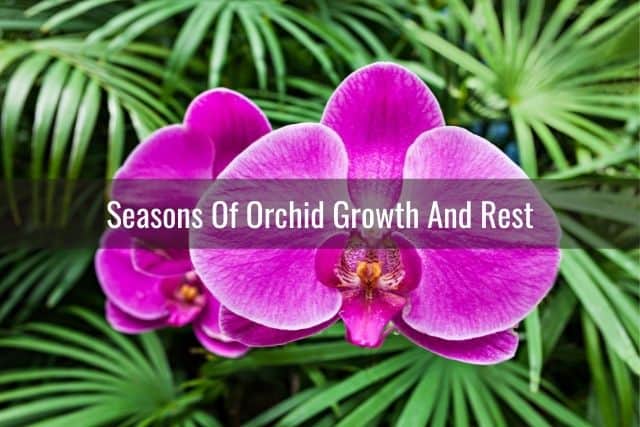
Phalaenopsis orchids are one of the most popular, most gifted orchids in the world. Many people receive these orchids as gifts or housewarming presents and may not be familiar with their care. They may look at their orchid, see no apparent changes or progress, and wonder if it is even growing. This is in part why some people throw away their orchids after it is done blooming.
This may come as a surprise to you if you are new to orchid growing, but orchids grow incredibly slowly. Over the course of a year, an orchid will move through different phases of growth, rest and blooming. In terms of how fast orchids grow, depending on the phase it is in, growth may be faster or slower during certain months of the year.
Becoming familiar with an orchid’s different phases and how fast an orchid grows is important. Once you know what to expect from your orchid, you’ll be able to tell whether your orchid is healthy and growing on schedule or not.
Blooming Phase
In the winter, Phalaenopsis orchids are nearing the tail end of their dormant stage. These orchids typically bloom during the late winter and early spring months.
Flower spikes will start to form in early to mid-winter. In some orchids, flower spikes will develop as early as late fall.
Once the flower spikes are formed, flower bud development ramps up in mid-winter. From start to finish, it takes about 3 months for the orchid to develop blooms.
From late winter to early spring, many Phalaenopsis orchids will experience their blooming season. Provided that the orchid has optimal growing conditions, Phalaenopsis orchid blooms can last up to 16 weeks on the flower spike.
Once the flower spike is cut, cut Phalaenopsis orchid blooms can last up to 2 weeks with the right care.
Orchid flowers can sometimes fall off early for a variety of reasons. If you notice that your orchid blooms only last a couple weeks, or that there is bud blast, there may be something wrong with your growing environment. Check out the top reasons why orchid flowers fall off early to learn more, and find out what you can do to fix it.
Resting Period
After the blooming season ends in the spring, Phalaenopsis orchids will undergo a brief resting period. During this time, it recuperates from the effort and energy it just spent during the blooming period. Your orchid will focus on harvesting energy during this time. Continue to give your orchid lots of bright, indirect light.
Orchid care during this time involves pruning and a slight decrease in watering and fertilization. You can read more about how to care for an orchid after the flowers fall off here.
Growth Phase
Following a brief resting period, the orchid jumps into the growth phase. This usually happens in the late spring to late summer months.
During the growth phase, your orchid will need more frequent watering and fertilization. To learn how to properly water your orchid, read this guide on how to water your orchid. You can also find out how to fertilize an orchid here.
If you have an orchid potted in moss, you’ll need a different approach. Learn how to water an orchid potted in moss here.
Make sure that your orchid has lots of bright, indirect light during this time. It will use that light energy to grow new roots and leaves. New root and leaf production will be the most obvious during the growth phase.
Dormancy
Growth will slow down as the orchid enters the cooler fall months. During the fall, the orchid transitions from the growth phase into another resting phase, or dormancy.
Some orchids, like the Dendrobium Nobile orchid, undergo a “winter rest,” where it does not need any watering or fertilization for a period of time. Phalaenopsis orchids, however, can still be watered and fertilized during this time, albeit less frequently.
So, during the late fall to early winter months, the orchid is officially in its dormant phase. This is an extended resting phase, where growth slows to almost non-existent levels. The orchid appears to be “sleeping” and you will not see much root or leaf growth during this time.
That doesn’t mean that the orchid isn’t working though. Keep providing your orchid with lots of bright, indirect light, humidity, and water (unless it is a species that needs a winter rest). Use a hygrometer to monitor your home’s humidity levels.
If you don’t have much natural lighting in your house, you may need to use artificial lighting to supplement your orchid’s light needs. Read more about setting up artificial lighting for orchids here.
The drop in temperatures during the fall signals to the orchid that winter is coming and to start bloom production. Flower spikes will start to grow during late fall or early winter.
How Fast Do Orchid Leaves Grow?
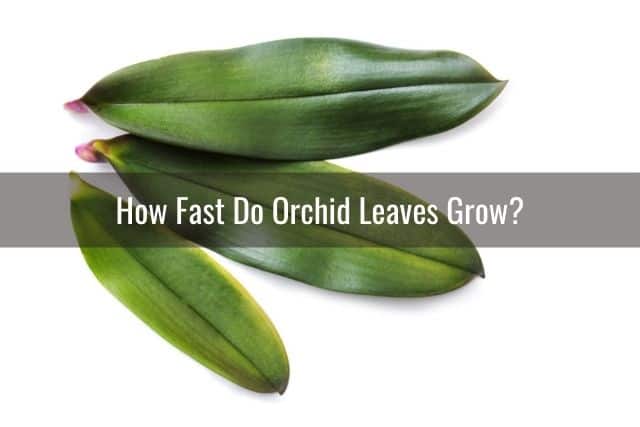
So, as I outlined above, an orchid will go through various phases of growth and rest within a year’s time. Depending on the phase that the orchid is in, the speed at which an orchid grows will vary.
Phalaenopsis orchids are monopodial orchids, meaning they produce one upright stem. Leaves are produced from the base of this stem and are arranged opposite each other in a stacked, evenly spaced fashion.
New leaves will start as a tiny leaf sprouting from the center of the two top leaves. It may take as much as 2 or 3 months for that leaf to grow to half the size of the other leaves.
In general, Phalaenopsis orchids will grow anywhere from 1 to 3 new leaves a year. New leaf growth is most apparent during the summer months, when the orchid is in the middle of its growing season.
How Long Does It Take For An Orchid Flower Spike To Grow?
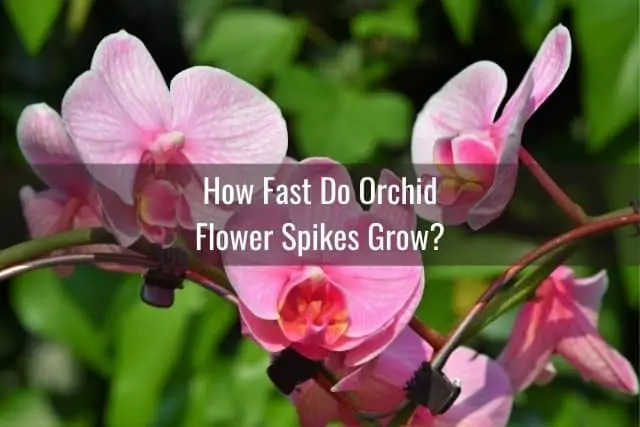
Phalaenopsis orchids will typically start focusing their energy on bloom production during the late fall and early winter months. Blooming usually happens during the late winter and early spring time. From start to finish, it usually takes an orchid about 3 months to flower.
Let’s break it down further. It will take about 2 months for an orchid to produce and grow a flower spike. The flower spike will usually start to grow in late fall. It will take an additional month for the flower buds on the spike to grow and develop to the point of blooming.
If your orchid is not developing flower spikes as it should, or misses a blooming season, you may need to make some adjustments in your orchid’s growing environment.
Usually, orchids need a nighttime temperature drop by about 15 to 20 degrees Fahrenheit for at least 2 weeks in the fall. This is necessary in order to trigger bloom production in the orchid.
For example, if daytime temperature highs were 75 degrees Fahrenheit, you will need to expose your orchid to a nighttime temperature between 55 to 60 degrees Fahrenheit. This will need to happen consistently over at least a 2 week period to have an effect.
The drop in temperature is a key signal to the orchid to initiate flower spike production. Use a thermometer to keep an eye on the temperature highs and lows. If you keep your orchids indoors, try to leave them near a slightly open window at night to expose them to this temperature drop.
You can learn more about how to trigger blooming and reblooming in orchids here.

Why Do Some Phalaenopsis Orchids Bloom “Out Of Season”?
While most Phalaenopsis orchids will bloom during late winter to early spring, keep in mind that many orchid sellers can initiate bloom production in an orchid on demand. They do this by manipulating temperature and environmental conditions within the greenhouse. This is how some orchids bloom out of season and that is why there are always blooming Phalaenopsis orchids sold in stores year-round.
If you are bringing a blooming Phalaenopsis orchid home during the summer or fall, it will most likely will not bloom again during the next blooming season. The reason for this is that the orchids have not had a chance to store up energy or prepare for another round of bloom production, especially so soon after the last one.
Case in point, I have some new Phalaenopsis orchids that were gifted to me back in September (early fall). It is now December (late fall/early winter) in the United States and those orchids are still in bloom.
Technically the new blooming season should start in a couple of months during late winter, but I don’t expect that this will happen for these orchids.
Instead, I am betting that these particular orchids will finish their blooming season this month or next, then enter an extended resting phase until the spring. Once the weather begins to warm up in the late spring, these particular orchids of mine will likely start their growing phase. After that, they’ll be on the same “schedule” as the other orchids.
Long story short, not all orchids will follow the exact season-to-season timeline listed above for various reasons. A lot will depend on the growing conditions, age of the orchid, and other factors.
For example, if you have recently repotted your orchid, it may also skip the next blooming season. This is due to the orchid trying to acclimate to the new potting media and focusing its energies on root growth. Once you’ve had an orchid for at least an year, you should see it following the general season-by-season guide above.
How Fast Do Orchid Roots Grow?

On average, an orchid will take anywhere from 1 week to 2 months to grow a new root. The length of time varies based on the season the orchid is in, its overall health, and the growing conditions.
During the growth phase, the weather is warm and the orchid is receiving lots of light, water and fertilizer. Root growth will be faster during the growth phase, in the range of 1 to 2 weeks.
If your orchid is healthy and doing well, you should see many new root buds and lots of growth during this phase of the orchid’s life. Not seeing root growth during the summer months indicates that something is wrong with the orchid or it’s growing environment.
An orchid will grow multiple new roots and elongate other roots during spring and summer. When the weather starts to cool down, root growth will likewise also slow down.
It also goes without saying that a sick, stressed, diseased or pest-infested orchid will have minimal to no growth. It will struggle to grow new leaves or roots. In these situations, growth of existing roots will be very slow or barely noticeable. If the orchid is in very bad shape, it might even develop a keiki as a last ditch effort to pass on its genes.
How To Tell If A Root Is Still Growing
Not every root on an orchid will continue to grow forever. Look at the ends of the roots and look for growing tips. This will let you know if that particular root is still growing. Growing tips will be a bright green or purple-colored tip. If you see these growing tips on an orchid root, it is a sign that the orchid root is still growing.
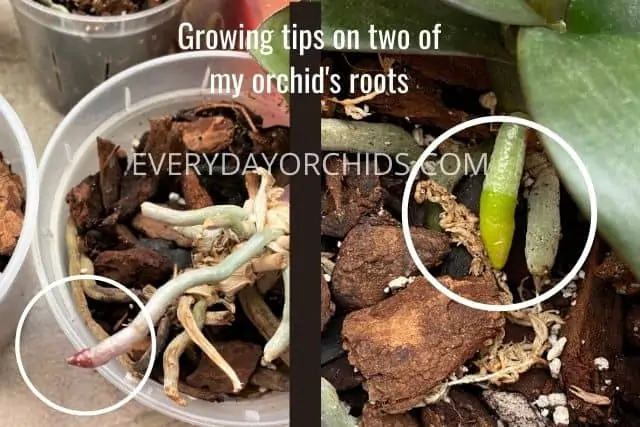
In contrast, orchid roots that are completely covered with silvery-gray velamen from beginning to end are done growing. While still functional and alive, they will not grow any longer than they already are. However, it is possible that new root buds may develop and branch off of these existing older orchid roots.
Why Is My Orchid Not Growing?
Sometimes, orchid growth can stall. This can be for a number of reasons, including sub-optimal growing conditions, not enough fertilization, not enough light or water, or lack of humidity. An orchid under attack by pests or dealing with a bacterial, viral or fungal infection will show stalled growth as well.
Remember, even in the best of times, orchids don’t grow very fast. In addition, an orchid will focus most of its energy and growth into one thing at a time, whether it is flower production or leaf and root growth. If the orchid is focused on growing a flower spike and on bloom production during late winter, leaf and root growth will take a backseat. Likewise, leaf and root growth, rather than flowers, are the focus during summer months.
Final Thoughts
Still wondering how fast do orchids grow? In summary, if you have a Phalaenopsis orchid, expect that your orchid will grow 1 to 3 new leaves a year, along with multiple new roots and root buds. During the blooming season, you should see at least one flower spike grow over a 2 to 3 month period. The flowers should last anywhere from 12 to 16 weeks.
As you can see, orchids tend to grow slowly over the course of the year. If well-cared for, orchids can live for decades. Slow growth is normal for orchids and not a sign that you are doing anything wrong. On the contrary, if you see your Phalaenopsis orchid putting out new leaves and roots each year, and reblooming each blooming season, that is a sure sign that it is happy and well-cared for.
As always, happy orchid growing!
If you enjoyed this article, please pin it and share!


